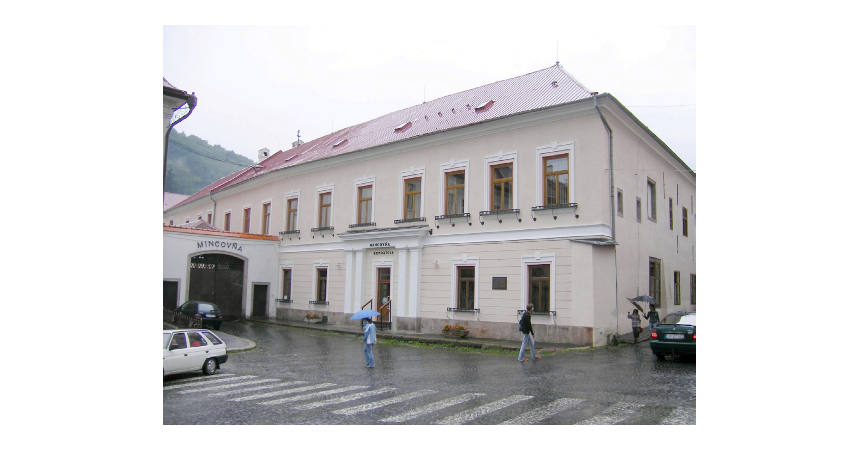Slowakische Nationalbank – Museum für Münzen und Medaillen in Kremnica
Wenn es kein Logo gibt, wird diese Spalte einfach leer gelassen. Das Bild oben bitte löschen.
(Dieser Text wird nicht dargestellt.)
Štefánikovo námestie (Štefánik Platz) 11/21
967 01 Kremnica
Tel: +421 (0)45-6742696
Das Münz- und Medaillenmuseum der Slowakischen Nationalbank wurde im Jahr 1890 gegründet. Ursprünglich befasste es sich nur mit der Stadt Kremnica und der Region, aber 1976 wurde es zu einem spezialisierten Museum für Numismatik. Die berühmte Münzprägeanstalt der Stadt, die auch unter ihrem deutschen Namen Kremnitz bekannt ist, wurde 1328 unter der Herrschaft des ungarischen Königs Karl I. gegründet und stellt noch immer Münzen und Medaillen für die Slowakei sowie Münzen für über 25 Länder weltweit her.
Das Museum verfügt über verschiedene Sammlungen, darunter wertvolle Exponate aus den Bereichen Numismatik, Medaillenkunst, Geschichte und bildende Kunst, die insgesamt rund 100 000 Objekte umfassen. Die Ausstellung wird sowohl auf Slowakisch als auch auf Englisch präsentiert.
Zwei Gesichter des Geldes
Die Ausstellung „Zwei Gesichter des Geldes – Geld und Medaillenherstellung in der Geschichte der Slowakei“ befindet sich in einem gotischen Bürgerhaus auf dem historischen Platz. Sie zeigt die Geschichte und Entwicklung des Geldes in der Slowakei von der Antike bis zu den heutigen Münzen und Banknoten sowie die Geschichte der Medaillenherstellung. Ein wichtiger Teil der Ausstellung ist der Geschichte der alten Bergbau- und Münzstadt Kremnica mit ihrer berühmten Münzstätte gewidmet.
In der ersten Etage erfahren die Besucher mehr über die komplexe Geschichte des Geldes in der Slowakei von den ältesten Zeiten bis zur Gegenwart, wobei ein besonderer Schwerpunkt auf der Produktion der Münzanstalt von Kremnica liegt. Der Besucher erfährt auch etwas über die Entwicklung der Münzprägung seit dem Mittelalter und sieht eine Ausstellung von Münzprägemaschinen und vielen seltenen Probestücken.
Die ältesten Münzen, die in der heutigen Slowakei geprägt wurden, stammen von den Kelten aus dem 3. bis 1. Jahrhundert vor Christus. Es folgt eine Darstellung der römischen, byzantinischen und westeuropäischen Münzen, die in der Slowakei vom Beginn der gemeinsamen Zeitrechnung bis zum 10. Jahrhundert genutzt wurden.
Prägemethoden
Die ältesten ausgestellten Münzen wurden in Kremnica bis zum 17. Jahrhundert manuell mit einem Prägestempel und einem Hammer auf einem Block geprägt. Nach und nach führte die Münzanstalt Kremnica die maschinelle Prägung ein; ab 1661 wurde eine Münzwalzmaschine und ab 1710 eine Münzschneckenpresse, die sogenannte Balancier-Maschine, eingesetzt. Ab dem 19. Jahrhundert gehörten automatische Münzprägemaschinen zur technischen Ausstattung der Münzanstalt. In einem anderen Raum werden die verschiedenen Währungen der multinationalen Habsburgermonarchie sowie die Bemühungen um eine Währungsunion gezeigt. Die Geschichte des Papiers als Zahlungsmittel in Ungarn reicht bis ins Jahr 1762 zurück. Die Besucher können das Inflationsgeld aus den napoleonischen Kriegen, das Geld der Revolutionäre in Ungarn (1848-1849), die Banknoten der Österreichisch-Ungarischen Bank und die ersten tschechoslowakischen Banknoten besichtigen.
Neuere Währung
Die jüngere Geschichte wird durch die Betrachtung von Münzen und Banknoten nach 1948 lebendig, darunter auch Exemplare von Münzen, die nicht in Umlauf gebracht wurden. Die Ursprünge der slowakischen Währung von 1993 werden sehr detailliert dargestellt – vom Druck der tschechoslowakischen Banknoten über die künstlerische Gestaltung der Münzen bis hin zur endgültigen Version der Slowakischen Krone. Zum Schluss werden die Umstände der Einführung des Euro in der Slowakei ab 2009 dargestellt.
Im zweiten Stockwerk können die Besucher die Geschichte der Medaillenherstellung in der Slowakei nachvollziehen. In einer einzigartigen Installation im Untergeschoss sind Beispiele für einzelne Typen historischer Bergbaustollen in den Andesit gegraben worden. Die Stollen reichen von den ältesten Zeiten bis in die Gegenwart, außerdem sind verschiedene Bergbauwerkzeuge, Bergbauwagen und andere Geräte ausgestellt.
Dieser Text wurde von Howard M. Berlin verfasst und erstmals in seinem Buch The Numismatourist im Jahr 2014 veröffentlicht.
Sie können seinen numismatischen Reiseführer bei Amazon bestellen.











